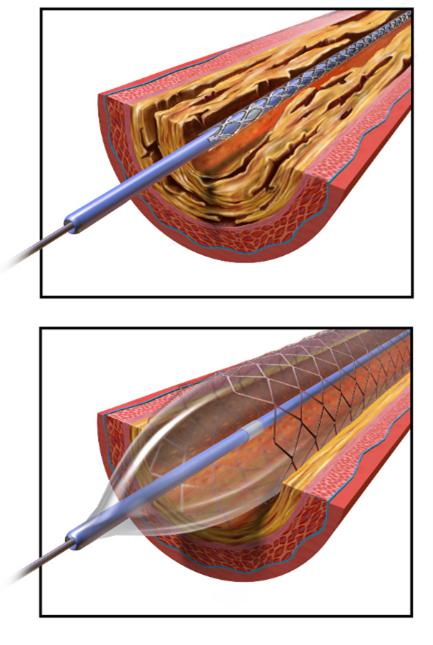What is an Angioplasty Procedure?
Angio meaning this is related to the blood vessels. Plasty refers to a surgical procedure to repair or restore an area. Angioplasty is a procedure to restore blood flow to the arteries using a special catheter with a balloon that can inflate or open blockages in the artery. The vascular doctor can place an arterial stent or a tube inserted to help restore proper blood flow.

Photo attribution: BruceBlaus / CC BY-SA
What to expect?
Preoperative Clinical instructions
Detailed history needs to be obtained:
- Previous malignant disease
- Previous surgical history including history of venous catheterization or trauma
- Previous history of radiation
- Family history of venous disease
Careful physical examination is mandatory
- Pulses in the affected extremity
- Diameter discrepancy between affected/unaffected extremity
- Ulcerations or skin changes
- Various examinations to rule out any other possible vascular conditions.
What to expect during this procedure?
This is a minimally invasive outpatient procedure requiring no hospital stay with a short recovery period. Most procedures allow patients to return to normal activity within a few days.
Medicine will be administered through an IV to keep you comfortable but awake. A local anesthetic is usually given in the groin area where a needle will be inserted. The catheter is threaded through this needle. You will feel pain when the needle breaks the skin, but the passage of the catheter through the blood vessel is painless.
During the Angiogram procedure, you will be asked to stay still and not move so that the images that are taken will be clear.
The dye allows the doctor to view your arteries on an X-ray monitor. A device with a small balloon on its tip is then inserted through an artery in your leg or arm and threaded through the arteries until it reaches the desired area. The balloon is inflated to flatten the plaque against the wall of the artery, opening the artery and restoring blood flow. Then the balloon is deflated and removed from your body.
Lower level anesthesia: Patients receive minimal anesthesia delivery under constant monitoring.
Postoperative instructions
Refrain from any heavy lifting (i.e. no more than 10 pounds), straining, pushing, or impact exercises (i.e. running, jogging, cycling) for the first 3 days. You may walk, climb steps and even drive, so long as you do not have excessive bruising, swelling, or pain at the puncture site.
You will be discharged with a dressing over the puncture site. This may be removed the next morning. Please inspect the puncture site daily for the first few days and notify us of any significant changes. Bruising around the area may be present. If you notice bleeding, swelling, or an increase in bruising apply constant direct pressure over the area and seek medical attention IMMEDIATELY.
Refrain from soaking in a bathtub or hot-tub or pool until puncture is healed.
Benefits of Angioplasty with CVM
A minimally invasive procedure that requires no hospital stay with a short recovery period. This means most procedures allow patients to return to normal activity within a few days. Other benefits include:
- Smaller incisions
- Less pain
- Minimal to no scars
- Less blood loss
- Lower rate of complications
Risks of Endovascular Procedures
Every procedure entails a certain level of risk. The advent of new technology and the experience of vascular doctors help minimize risk. Here is a list of possible risk factors that may arise.
Catheter-Related Risks
Any procedure that involves the placement of a catheter inside a blood vessel carries certain risks. These risks include damage to the blood vessel, bruising or bleeding at the puncture site, and infection. The chance of any of these events occurring is less than one percent.
Allergy to X-ray Contrast Material
Patients may have an allergic reaction to the x-ray contrast material used during endovascular procedures. These episodes range from mild itching to severe reactions that can affect breathing or blood pressure. Patients having procedures are carefully monitored by a physician and a nurse during the procedure.
X-ray exposure
Endovascular procedures are done under x-ray. Exposure levels usually are well below those where adverse effects on the patient or future children would be a concern.
Potential Adverse Effects on the Kidneys
Patients with a history of poor kidney functions are at higher risk of further damage. Blood work will be drawn to help identify patients at risk and levels will be monitored accordingly. IV fluids will also be given during and after the procedure to dilute the dye and filter the dye through the kidneys. In very rare cases additional medication may need to be given.
Medications to avoid
Outside of certain blood-thinning agents, most medications can be continued immediately following your procedure. Medications such as Coumadin (Warfarin) and injectable Heparin/Lovenox are potent blood thinners that can cause delayed bleeding from teh puncture site. We usually ask that these blood thinners be held for 1-2 days following the procedure, we will specify when to begin use of these medications.
If you take aspirin, Plavix, or Aggrenox, you may continue the use of these medications so long as there are no signs of delayed bleeding or swelling at the puncture site.
